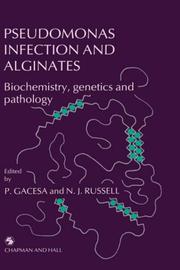| Listing 1 - 10 of 20 | << page >> |
Sort by
|
Book
Year: 2020 Publisher: London : IntechOpen,
Abstract | Keywords | Export | Availability | Bookmark
 Loading...
Loading...Choose an application
- Reference Manager
- EndNote
- RefWorks (Direct export to RefWorks)
Alginates are polysaccharides found in both the intercellular matrix of brown algae and extracellularly covering some species of bacteria. Alginate varies in composition of the algae from 20% to 60% dry matter, but on average brown algae species has 40% alginate. Alginate from brown algae occurs as gels containing sodium, calcium, strontium, magnesium, and barium ions. They are widely used by the food industry, giving foods texture properties such as thickening, adhesion, emulsification, gelling, or fullness. This book covers the latest uses of this phycocolloid in the pharmaceutical, medical, and technological fields, namely bioink for 3D bioprinting in tissue engineering and regenerative medicine, and the application of artificial intelligence in modern healthcare systems.
Book
Year: 2020 Publisher: London : IntechOpen,
Abstract | Keywords | Export | Availability | Bookmark
 Loading...
Loading...Choose an application
- Reference Manager
- EndNote
- RefWorks (Direct export to RefWorks)
Alginates are polysaccharides found in both the intercellular matrix of brown algae and extracellularly covering some species of bacteria. Alginate varies in composition of the algae from 20% to 60% dry matter, but on average brown algae species has 40% alginate. Alginate from brown algae occurs as gels containing sodium, calcium, strontium, magnesium, and barium ions. They are widely used by the food industry, giving foods texture properties such as thickening, adhesion, emulsification, gelling, or fullness. This book covers the latest uses of this phycocolloid in the pharmaceutical, medical, and technological fields, namely bioink for 3D bioprinting in tissue engineering and regenerative medicine, and the application of artificial intelligence in modern healthcare systems.
Book
Year: 2020 Publisher: London : IntechOpen,
Abstract | Keywords | Export | Availability | Bookmark
 Loading...
Loading...Choose an application
- Reference Manager
- EndNote
- RefWorks (Direct export to RefWorks)
Alginates are polysaccharides found in both the intercellular matrix of brown algae and extracellularly covering some species of bacteria. Alginate varies in composition of the algae from 20% to 60% dry matter, but on average brown algae species has 40% alginate. Alginate from brown algae occurs as gels containing sodium, calcium, strontium, magnesium, and barium ions. They are widely used by the food industry, giving foods texture properties such as thickening, adhesion, emulsification, gelling, or fullness. This book covers the latest uses of this phycocolloid in the pharmaceutical, medical, and technological fields, namely bioink for 3D bioprinting in tissue engineering and regenerative medicine, and the application of artificial intelligence in modern healthcare systems.
Book
Year: 1968 Publisher: London : Alginate industries,
Abstract | Keywords | Export | Availability | Bookmark
 Loading...
Loading...Choose an application
- Reference Manager
- EndNote
- RefWorks (Direct export to RefWorks)
Book
ISBN: 1789856426 1789856418 Year: 2020 Publisher: London, United Kingdom : IntechOpen,
Abstract | Keywords | Export | Availability | Bookmark
 Loading...
Loading...Choose an application
- Reference Manager
- EndNote
- RefWorks (Direct export to RefWorks)
Multi
ISBN: 9780128176412 0128176415 0128176407 9780128176405 Year: 2020 Publisher: London Academic Press
Abstract | Keywords | Export | Availability | Bookmark
 Loading...
Loading...Choose an application
- Reference Manager
- EndNote
- RefWorks (Direct export to RefWorks)
Book
Year: 2012 Publisher: Adelphi, MD : Army Research Laboratory,
Abstract | Keywords | Export | Availability | Bookmark
 Loading...
Loading...Choose an application
- Reference Manager
- EndNote
- RefWorks (Direct export to RefWorks)
Microbial fuel cells. --- Biofilms. --- Anodes. --- Alginates. --- Catalysts.

ISBN: 0412358409 9401073198 9400918364 Year: 1990 Publisher: London New York Madras Chapman and Hall
Abstract | Keywords | Export | Availability | Bookmark
 Loading...
Loading...Choose an application
- Reference Manager
- EndNote
- RefWorks (Direct export to RefWorks)
Alginates --- Pseudomonas Infections --- Pseudomonas aeruginosa infections --- Physiological effect --- Pathogenesis --- Alginates. --- Pseudomonas Infections.
Dissertation
Year: 2000 Publisher: Liège : Université de Liège. Faculté de médecine (ULg). Département de clinique et pathologie médicales,
Abstract | Keywords | Export | Availability | Bookmark
 Loading...
Loading...Choose an application
- Reference Manager
- EndNote
- RefWorks (Direct export to RefWorks)
CHONDROCYTES --- CELL CULTURE --- CULTURE MEDIA --- ALGINATES --- METABOLISM --- CHONDROCYTES --- CELL CULTURE --- CULTURE MEDIA --- ALGINATES --- METABOLISM
Book
ISBN: 8716149599 Year: 1992 Volume: 28, vol. 100, 1992 Publisher: Copenhagen Munksgaard
Abstract | Keywords | Export | Availability | Bookmark
 Loading...
Loading...Choose an application
- Reference Manager
- EndNote
- RefWorks (Direct export to RefWorks)
Lungs --- Infections --- Pseudomonas aeruginosa infections --- Pathogenesis --- Alginates --- Physiological effect --- Cystic fibrosis --- Physiology [Pathological ]
| Listing 1 - 10 of 20 | << page >> |
Sort by
|

 Search
Search Feedback
Feedback About UniCat
About UniCat  Help
Help News
News